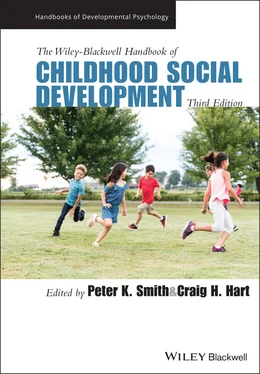Parenting characteristics, behaviors, and interactions . Concern that parenting styles were not as robust as originally conceptualized (Maccoby, 2015) precipitated a movement away from static typologies toward models that emphasized dynamic features, such as parenting behaviors and interactions. Some researchers studied features that were implied within parenting typologies (e.g., warmth) whereas others focused on attributes drawn from other theoretical perspectives, including dyadic constructs (e.g., connectedness, synchrony, autonomy support). Both avenues proved productive. For example, components of authoritative parenting were found to predict children’s social competence from infancy into adolescence (Valiente et al. 2009). Conversely, authoritarian parenting was linked with children’s aggressive and disruptive behaviors (Pascual‐Sagastizabal et al., 2014). Likewise, studies of parent–child interactions revealed that dyadic features such as connectedness and synchrony were similarly or more strongly linked with child competence (Mize & Pettit, 1997).
Other trends included the study of child effects and bidirectional parent–child influences. Studies of child effects supported the notion that children’s actions evoke different forms of parenting (Newton et al., 2014) and that parenting influences are moderated by children’s temperaments (Kochanska & Kim, 2013). Research on bidirectional patterns of influence corroborated the premise that early child behaviors and emotions shape later parenting (e.g., punitiveness; warmth), and vice versa (Lengua & Kovacs, 2005).
Parental discipline and moral socialization were examined with multiple dimensions of children’s social development. Prominent objectives included evaluating parent–child interaction and disciplinary practices that were hypothesized to render particular socialization outcomes (e.g., higher levels of moral reasoning; responsible behavior). Key findings suggested that everyday parent–child discussions encompassing moral themes (e.g., rules, issues, conflicts) promoted growth in children’s moral reasoning (Dunn, 2006) and that positive parent–child relations fostered growth in children’s conscience and moral behavior (Kochanska et al., 2010). Investigation of the relative merits of inductive as opposed to assertive or hostile discipline revealed that, whereas induction forecasted children’s prosocial‐moral beliefs and behavior (Hart et al. 2003), assertive and hostile discipline predicted antithetical outcomes (Baumrind et al., 2010).
Cultural contrasts . Researchers also compared Western socialization practices to those found in other cultures. In cross‐national comparisons, for example, differences were found in parent’s perceptions of their children’s temperamental and behavioral characteristics (Russell et al., 2003), but similarities were reported for the consequences of particular parenting styles (e.g., authoritarian parenting and child aggression; Nelson et al., 2014). Other findings showed that parenting effects varied depending on the family’s ethnicity and cultural context. To illustrate, researchers found that, when compared to White or Hispanic youth, African‐American adolescents were less likely to participate in gangs or gang‐related delinquency if their parents abstained from lax discipline and wielded greater control over children’s behavior (Walker‐Barnes & Mason, 2001).
After a period of dormancy following World War II, research on children’s peer relations reemerged in the 1970s and expanded thereafter (Ladd, 2005). A key impetus was the premise that peer socialization prepared children to succeed in multiple spheres of life, including romantic and workplace relations.
Focal areas of inquiry included children’s peer interactions, relationships, and groups. Seminal work described the character of peer interactions and behavior (e.g., prosocial, aggressive, withdrawn) in varying social contexts (e.g., classrooms, playgrounds), explicated relationship processes and consequences (e.g., friendship formation, maintenance, termination, e.g., Parker & Seal, 1996; bully–victim dynamics, Veenstra et al., 2007), and probed the process by which children access and acquire status in peer groups (e.g., peer group entry, acceptance, rejection; Bukowski et al., 2018).
Evidence linking children’s behavior with the quality of their peer relationships led investigators to search for the origins of social “competencies” and skill “deficits” (Ladd, 2005). Among the determinants examined were the social‐cognitive underpinnings (Gifford‐Smith & Rabiner, 2004) and the parenting and family processes associated with children’s behavior amongst peers (Ladd & Kochenderfer‐Ladd, 2019).
Another key objective was to confirm and extend early longitudinal findings suggesting that the quality of children’s peer relations during childhood predicted their health and adjustment in adolescence and adulthood. A new wave of prospective longitudinal studies largely substantiated this premise. Childhood peer rejection, victimization, and friendlessness forecasted a variety of later‐life social difficulties and dysfunctions (Ladd, 2005).
Peer relations research eventually broadened to incorporate diverse ethnic and cultural contexts. Within North America, for example, researchers discovered that whereas Euro‐American children had more cross‐ethnic friendships than African‐American children (Kawabata & Crick, 2008), African‐American children had a larger number of friendships and more opposite‐sex friendships (Kovacs et al., 1996). Internationally, research on bullying that had originated in Norway spread to many other nations. Additionally, cross‐national comparisons were made of children’s friendships, peer group relations, social behavior, and interpersonal competencies (Chen et al. 2018).
Childcare and schooling contexts
Cultural and economic changes made childcare and formal schooling foci for social development research. A primary aim for childcare research, as detailed later, was to elucidate the impact of early nonparental care on young children’s socioemotional development. Another investigative thrust centered on the evaluation of compensatory programs for economically disadvantaged preschoolers. Programs such as Head Start, which were designed to prepare children for school, eventually expanded their objectives to include social as well as pre‐academic competencies (Raver & Zigler, 1997).
With older children, researchers endeavored to elucidate the social features and consequences of formal schooling (Wentzel, 2015). Inquiry was wide‐ranging and included factors such as school structure and organization (e.g., size, gender groupings, school transitions, race/ethnic composition), instructional environments and methods (e.g., open vs. traditional classrooms, didactic vs. peer‐mediated learning), and classroom interpersonal dynamics (e.g., classmate and teacher–child relations). Among other discoveries, researchers found that smaller schools facilitated children’s engagement in extracurricular activities which, in turn, predicted favorable student outcomes (Schaefer et al., 2011). School transitions, in contrast, were associated with unfavorable student outcomes, such as stress, declining self‐esteem, and disengagement (Eccles & Roeser, 2003). Research on classroom instruction and dynamics revealed, among other findings, that peer‐mediated learning improved children’s collaborative and interpersonal relations with classmates (Roseth et al., 2006; Tolmie et al., 2010).
Research on after‐school arrangements for school‐age children arose in response to the growth of dual‐ earner families. Studies of self‐care (i.e., allowing children to look after themselves after school) often documented hazards and risks (e.g., stress, drug use, antisocial behavior; Lord & Mahoney, 2007). In contrast, children were found to benefit from structured, adult‐supervised after‐school programs (Vandell et al., 2005).
Читать дальше












